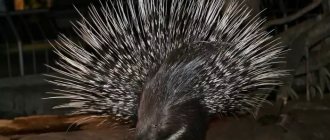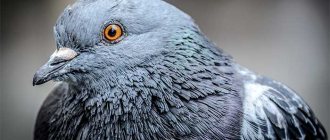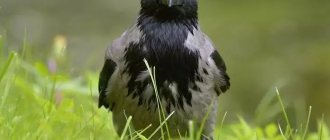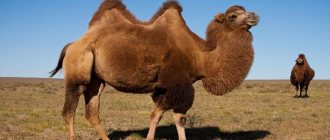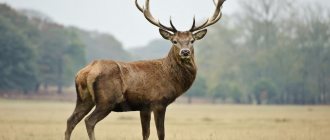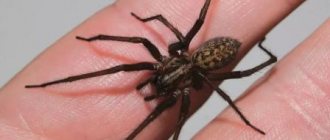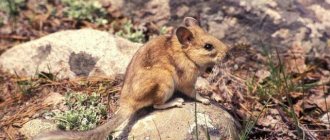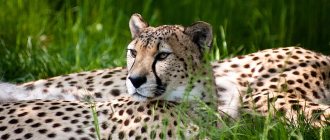Perhaps the readers of our site know better than others how many animals exist on our planet. Previously, we have already managed to study many interesting creatures, including the blackest fish in the world . In this material, I propose to understand why animals need horns, how they grow, and who has the largest ones. I will say right away that African cows, called Watussi (Ankole-Watusi), are considered to have some of the largest horns. Once upon a time, African tribes considered them sacred and used them to the maximum, breeding them for milk, meat and even blood. And they called them “insangs,” which can be translated as “cows with very long horns.” But how big do their horns reach, what role do they play in their body, and how did these unusual cows manage to spread almost throughout the world? After all, today they can be found not only in Africa, but also in the USA, Ukraine and a number of other countries.
It may seem like it's photoshopped, but it's not.
The blackest fish in the world are called long-horned sabertooths (Anoplogaster cornuta). You can look at their photographs here, but let's first study the most horned creatures.
Horned snails
When talking about horned animals, snails are the last thing people remember. Nevertheless, they exist. Horned snail is a popular name. Their scientific name is Horned Nerite Snail. On the shell of these snails there are horn-like processes that have an unusual structure. If you pick up this creature, you can even get hurt by its horns.
The cute faces of horned snails
While in an aquarium, the horned snail is not able to reproduce. The situation is completely different when it is in sea water. This species of snail is the smallest neritoid species kept in aquariums. The average size of Horned Nerite Snail is about a centimeter in diameter. Typically, the size of an adult does not exceed two centimeters in diameter.
Horned snails live quite a long time; their life in an aquarium can continue until they leave the aquatic environment. It is important not to scoop them up and never squeeze them in your hand, as the antlers can hurt your hands.
The long horns of these snails can hurt
It has been noticed that throughout life, the processes on the shell of a horned snail do not grow with it, remaining forever the same size. You can't help but pay attention to these mollusks because of their unusual contrasting colors. They have a black and yellow color, but there are variations and different inclusions.
These long horns no longer grow over the course of the snail's life.
Each snail's horns are located differently; no pattern can be discerned. Most often they are at the top of the shell. Particular care should be taken when handling horned creatures during transportation, as their horns can be easily damaged.
How did cows appear?
It is believed that the ancestors of the Watussi are primitive bulls, also called aurochs (Bos primigenius). In their behavior they were similar to ordinary cows and differed only in the outstanding size of their horns. These creatures lived on our planet until 1627 and became extinct due to human activity. However, the last individual known to science died not due to the fault of people. She died in one of the Polish forests due to illness. Most likely, it could infect other individuals, so they had absolutely no chance of survival.
Primitive bull as imagined by the artist
Animals with long horns
There are several species of animals whose horns can be considered long. These are the bango antelopes. They live in Central Africa. Powerful meter-long horns are not easy for these animals to carry, since their own height barely reaches a meter and a quarter. Bangos grind their horns down on trees and rocks to keep them sharp, but they are almost never used to attack antelopes.
Bango antelopes sharpen their long horns on trees
Waterbucks are distinguished by their long horns; they are large antelopes with shaggy hair. Their horns are about a meter long.
Long twisted horns adorn the head of the Snow Ram. From time to time, representatives of this species engage in battles with their horns so that the knocking can be heard over a long distance. An animal such as a mountain goat has large horns, and they are especially long in males. Some individuals have horns that grow up to a meter.
The wild goat found in Europe is called mouflon. Its horns are particularly wide at the base. They grow throughout life, twisting in a spiral.
Mouflon rams have horns that grow in length throughout their lives.
The sika deer has large antlers with numerous branches. Red and reindeer can boast similar horns, but thicker. It is known that in harsh climatic conditions the number of processes on the horns increases significantly. After the mating season, deer shed their antlers, and they grow back only for the next season. When talking about animals with long horns, one cannot help but think of roe deer and moose. African savannas are home to Thomson's gazelles and Grant's gazelles. Males are distinguished by especially long horns.
Deer.
In the wild , deer live in America and Eurasia, as well as in a small region in northern Africa. Only male deer have antlers. The exception is the reindeer, in which both males and females wear antlers. Deer antlers develop from cartilaginous tissue, and subsequently become overgrown with bone tissue and become hard. Antler growth begins early in the season, in spring. Every year, deer lose their antlers and grow them back. After the deer sheds its antlers, the top of the bone stump is overgrown with a special cartilaginous cap covered with skin. A new, young horn will develop from this cap next year. Growing antlers, also called antlers , are very sensitive, as they are penetrated by blood vessels and nerves . Antlers have healing properties and, therefore, many antlered deer are mercilessly destroyed in order to obtain these young antlers. Deer are herbivores, feeding on buds, branches, leaves, bark, as well as herbs and moss. Deer prefer softer plant foods compared to bulls. deer often personify nobility, greatness, beauty, grace and speed. In Christian culture they symbolize hermitage, piety and purity.
Noble European deer.
European Red Deer
European Red Deer has a height at the withers of up to 1.5 m, a length of 2.0-2.5 m, and a weight of up to 300 kg or more. Females are about half the size of males. The fur color is red-brown in summer, gray-brown in winter. The tail is up to 15 cm long, reddish-yellow on a light yellow surface. Wide eye sockets. The age of a deer cannot be determined by its antlers alone. Rutting in September, shedding horns from January to March, new horns grow by July - August; reindeer lambing in June. The distribution area of the red deer is considered to be Western Europe, Scandinavia, China, as well as Australia and New Zealand. The red deer has antlers with a large number of processes (usually at least five), which form a kind of recognizable crown at the top of the horn.
White-tailed deer.
White-tailed deer
White-tailed deer is an American deer that lives in southern Canada, the United States and northern South America. The habitat of these deer is very diverse: forests, steppes, semi-deserts and swamps. White-tailed deer adapt to local conditions everywhere. In the middle of the last century, they were brought to Scandinavia, where they quickly adapted. The sizes vary and depend on the regions where they live. The further north you go, the larger the animals are. Representatives of the species living in Canada and the northern United States weigh from 60 to 130 kg. Females are never heavier than 90 kg. To the south the deer become smaller. Their weight varies from 35 to 50 kg. Only males have horns . They shed them at the end of the mating season. New formations begin to grow in this place. There are processes on each of the horns. White-tailed deer have a varied diet. Animals eat leaves, grass, buds, berries, acorns, grains, and fruits.
Horns are, of course, very useful both for the bearers of the horns and for humans. But their beauty, even if the horns were completely useless, is simply mesmerizing! And we think this post is proof of that.
Zoya Bomze.
Goats with the longest horns
Among the goats, one can distinguish the mountain goat, its horns are curved back like a saber. The horns of a horned goat reach one and a half meters in length. They got this name because of their horns that looked like they were curled like abrasives. Powerful horns adorn the heads of aurochs. Their second name is Caucasian stone goats.
Huge and beautiful horns of a mountain goat
Alpine goats or ibex live in the European mountains. They rise to a height of more than three thousand meters. The horns of these animals begin to grow from three months. Every year in the summer a new horny sheath appears, pushing the old one upward. This is how a kind of annual rings are formed, indicating the age of the Capricorn. Each horn can reach a length of one meter and weigh about fifteen kilograms.
The bezoar goat lives in the mountains. Its main habitat is Dagestan. Unfortunately, the numbers of these animals are declining. Males have long horns. They are curved in shape like a saber. Females have much shorter horns.
Among bezoar goats, males have long and beautiful horns.
There is a record-breaking domestic goat. He lives in the USA. His name is Uncle Sam. The length of the horns of this goat is one hundred and thirty-two centimeters.
Goats and Rams.
The subfamily Goats and Rams (Caprinae) unites bovids that are diverse in appearance, belonging to 11 genera and 16-20 species. Despite noticeable differences in the size, structure and shape of the horns, the species included in this subfamily represent a single group, the extreme members of which are interconnected by a long chain of related forms.
Alpine ibex, ibex or ibex.
Alpine mountain goat, ibex or ibex
A distinctive feature of the mountain goat, ibex, is the huge curved horns, with transverse tubercles on the surface, reaching a length of up to 1 meter. Females also have horns, but they are shorter and barely curved. Both sexes have a goatee. In summer, males have a dark brown coat color, while females have a slightly reddish or golden tint. In winter, the coat of both sexes is gray. The habitat of ibex is alpine meadows, up to 3500 m above sea level. In winter, it descends lower, where it can find food under the snow. To spend the night, it usually goes higher into the mountains.
Ibex female
It is difficult to find an explanation for the size and shape of the horns of this amazing animal. One obvious reason is that the larger the horns, the more formidable the appearance for opponents. The second is that the more branched and intricate the horns are, the more attractive this goat will be to females.
Winkhorned goat or markhor.
The horned goat or markhor lives in Tajikistan (Kugitangtau, Babatag and Darvaz ranges), Uzbkistan (upper reaches of the Amu Darya), Turkmenistan (eastern part of the Kugitang mountains), as well as in East Pakistan, Afghanistan and north-west India.
Winkhorned goat or markhor
Markhor differs from other mountain goats: the horns of the mahur, located closely at the base, are twisted two to three turns, with the right horn twisting to the left and the left horn to the right. The trunk of the horn is strongly flattened, laterally compressed and has well-defined anterior and posterior ribs. Males have a long beard and chest fur. There are black stripes on the front of the legs. The body length of males is up to 1.7 m, the height at the withers is up to 1.0 m, weighs up to 90 kg, less often more, the weight of females is up to 60 kg. In males, the horns reach 1.5 m or more, while females have small horns, 20-30 cm in length. Markhor lives in the Western Himalayas, Kashmir, Little Tibet, Afghanistan, and Tajikistan. The horned goat inhabits the steep slopes of gorges, rocks and cliffs, at an altitude of 500 to 3500 meters, feeding on grass and leaves. It is the ancestor of some breeds of domestic goats. There are several subspecies of horned goats, differing in the shape of their horns. There was a belief that markhor meat neutralizes the effects of snake venom , and he himself finds snakes and eats them. This is where the name of the horned goat comes from - markhor , in Persian mar - snake , and khur - eating . In this regard, for a long time people have hunted these animals. Currently, hunting for horned goats is prohibited everywhere. The horned mountain goat easily overcomes steep gorges, and its unusual horns give the animal stateliness and grace.
Bighorn sheep or bighorn sheep.
Male bighorn sheep
The bighorn sheep or bighorn sheep (Ovis canadensis) is a species of artiodactyl from the genus sheep. Distributed in the mountains of western North America from Canada to California. The bighorn is a large cloven-hoofed mammal, with a rather dense and powerful build, with short and strong limbs, a thick, short neck, a small head and a tail slightly protruding from the fur. Males are on average significantly larger than females . They have heavy and massive horns that curve outward in a more or less gentle spiral. Their length is about 110 cm. The horns of females are well developed, but weaker than those of males. With a general, semi-crescent shape, they diverge sharply to the sides. Bighorn sheep live in mountainous areas, inhabiting alpine meadows and foothills. In summer they stay at altitudes of about 1800-2500 meters above sea level, in winter they descend lower to altitudes of 800-1500 meters. Bighorn sheep are well adapted to climbing steep rocky slopes. The bighorn head is an old logo for Dodge cars.
Argali mountain sheep
Argali mountain sheep
Mountain sheep Argali is a herbivorous, artiodactyl, bovid horned member of the sheep family, living in some areas of Central and Middle Asia, Mongolia, Kazakhstan in the east and west of Siberia, the Tien Shan, Palmyra, and the Sayan Mountains. Argali are found in the foothills of Nepal, the Himalayas, Tibet and some areas of Dagestan.
Argali is the largest representative of wild sheep - its length is up to 2 meters, its height at the withers is 1.2 meters, and its weight is up to 180 kg. Males differ from females in that they have a ring of light hair around the neck, as well as elongated hair on the nape. Both males and females have long horns , but in males they look much larger and more impressive. Horns up to 190 cm in length, twisted into a spiral with ends outward and upward; They are very popular among hunters - their price can reach several thousand dollars. Argali live in herds at an altitude of 1300-1600 m, preferring plateaus and gentle slopes. But, animals can often be seen on rocks, in areas where livestock have displaced them from more fertile and level areas. Argali descend into the valleys in winter and early spring, and in the summer they rise high into the mountains, to the border of alpine meadows and eternal snow. Argali feed on almost all plants that can be found in the area they inhabit. In summer, animals rise to the area of alpine meadows, where they find lush grass, and in winter, if the snow layer is very high, they descend into the valleys, where dry, last year’s grass, moss and lichens are obtained from under the snow. Mountain sheep constantly move from pasture to pasture in search of food. They run well on rocky slopes, can climb rocks and jump over wide gorges, and on the plain they run at a speed of 50-60 km per hour.
British sheep.
Swaledale
sheep is a breed of domestic sheep named after the Yorkshire Swaledale valley in England. They are found in the more mountainous areas of the UK, but especially in the Yorkshire Dales, County Durham, and around clearings in Canbria. Swaledale sheep are adapted to live in harsh weather conditions, with light, thick wool, curled horns and white fur on the nose and around the eyes, against a black head. They are used for meat production in northern England and also as breeding stock.
Bull with the world's largest horns
Recently, the title of the longest-horned bull was given to one of the representatives of the Texas Longhorn breed.
His nickname is JR. The Guinness Book of Records has officially recorded this title. This bull surpassed the previous record holder by as much as fifty-three centimeters. The length of the horns is two meters and seventy-four centimeters. The previous champion was from Ohio. His nickname is Shadow. The owner of the new record holder says that, despite his title, the bull continues to graze on the same lands, surrounded by kangaroos. He is still relatively young, which means that the horns may become even longer over time, because the life expectancy of representatives of this breed is about twenty years. Today his home is the Australian Wildlife Park.
Bull with the world's largest horns
But the largest horns in the world belong to another record holder - a Watusi bull named Kren. He lived in a shelter. The weight of each horn of this bull is about fifty kilograms, and the length is a little more than ninety-two centimeters. Kren was very friendly and not at all dangerous to humans. His record was recorded in the Guinness Book of Records in 2003. Unfortunately, the animal died in the same year, 2003.
Animals surprise not only with their horns. There are also more extravagant creatures. For example, according to uznayvse.ru, one of the most unusual animals on the planet is a dog whose fur grows over a meter in length and is very similar to dreadlocks.
Animal Reproduction
The mating season for these animals begins with the arrival of cold weather. This usually occurs in November or December. During the mating season, lambs descend from the mountains into the valleys and form flocks. The number of individuals in them is a maximum of 17. Moreover, females mature in the 2nd year of life. The duration of the mating season for each variety may be different.
Males form a kind of harem around themselves, which can include 9-30 females. During the mating season, they are characterized by aggressiveness. Rams chase females.
The loud sounds that animals make can be heard over long distances. At the same time, females fight with each other all the time in order to attract the attention of the male. After the end of the mating games, pregnancy comes. On average, it lasts 5-6 months. As a result, lambs are born. The birthing process usually takes place in narrow rocks, into which predatory animals cannot penetrate. There are usually 2-3 lambs in 1 litter. Moreover, their weight is 3-6 kilograms.
See also
Types and symptoms of mastitis in sheep, home treatment and preventionRead
In the first months, the lambs are weakened. They move with their mother all the time. Adult females form special herds, which include new litters and young animals born in the previous year. For six months, the female actively feeds the babies with milk. After this period is completed, young lambs themselves refuse milk. The young animals eat succulent green food, which helps build muscles and strengthen bones.
Features of character and lifestyle
Photo: Narwhal animal
Narwhals are sociable and peaceful creatures. They prefer cold waters, but in the fall, when water temperatures drop, they migrate south. During this period, many narwhals have young, which is why they also move to warmer waters.
Narwhals spend most of their time under the ice. Sometimes you can see the long tusks of males that have floated to the surface to the hole to take a breath of oxygen, and then sink back to the depths. If the hole is covered with ice, large male narwhals break it with their heads, but not with their tusks.
Narwhals, like dolphins, live in schools of about ten individuals. Males stay apart from females. Narwhals communicate using various sound signals and echolocation, but the exact number of sound signals is unknown. It can be reliably said that killer whales, dolphins and whales have a similar way of communication.
Interesting fact: Each pack of narwhals has its own sound designations, which will not be understood by another pack. It's like different dialects of the same language.
In the summer, narwhals migrate back north, either pregnant or with grown cubs. Sometimes single males swim at a distance from the flock - the reason for this behavior is unknown, since narwhals do not expel their relatives from the flock. These animals can dive to depths of up to 500 meters. They can remain without air for up to half an hour, but the cubs emerge to breathe every 20 minutes.
Narwhals do not attack other marine life without reason. They are also non-aggressive towards people, but, unlike dolphins and some whales, they do not show curiosity towards them. If narwhals see a boat near a pack, they prefer to slowly disappear from view.
Origin of the species and description
Photo: Narwhal
Narwhals are mammals belonging to the family and genus Narwhalidae - the only representatives of their genus. Narwhals are cetaceans - mammals that have been able to fully adapt to life in water.
It is difficult to establish the origin of narwhals, since their ancestors have not been found that would have a similar tusk, which grows from the head of narwhals. The closest relatives of narwhals are belugas; they have the same constitutional structure, with the exception of the structure of the oral cavity.
Video: Narwhal
Cetaceans have many similarities with artiodactyls. According to their genetic code, they are close to hippopotamuses, so it can be concluded that the ancient ancestors of narwhals were Mesonychia mammals. These animals were similar to wolves, but had paired hooves.
Mesonychia lived near the coasts and ate fish, crustaceans and mollusks. This diet forced the animals to often go into the water or live in swamps. Their bodies changed to suit the aquatic lifestyle - a streamlined body shape and compacted tails were formed. The nostrils of all cetaceans are located on the back - they perform exactly the same functions as the nose of land animals.
Interesting fact: The narwhal tusk is an amazing evolutionary phenomenon. When scientists reliably understand why these animals need it, many questions about the origin of the narwhal will be closed.
Why the narwhal does not have a dorsal fin is also an open question. Probably, due to the northern habitat, the fin was reduced - it was inconvenient when swimming on the surface, near a layer of ice. The fins of cetaceans have a fairly fragile structure, so narwhals could simply break them often on thick ice.
Where does the narwhal live?
Photo: Sea narwhal
Narwhals live only in the cold waters of the Northern Ocean, as well as in the North Atlantic.
The places where you can most often find herds of narwhals are as follows:
- Canadian Archipelago;
- the coast of Greenland;
- Spitsbergen;
- Franz Josef Land (from 2022);
- New Earth;
- south of Great Britain (wintering only);
- Murmansk coast;
- White Sea (also only in winter);
- Bering Islands.
Despite the many areas where narwhals live, their numbers are extremely low. This scattering makes it difficult to observe narwhals, which is why even today some individuals can become victims of poachers.
Narwhals lead a herd lifestyle. They usually live at depth, being in constant motion. Together with young and elderly individuals, they travel tens of kilometers a day in search of food. Narwhals remember places where there are holes in the ice to breathe.
Two herds of narwhals meet extremely rarely - using echolocation, they determine each other’s locations and avoid meeting each other. When meeting (they occur, most often, at wintering grounds), they make greeting sounds, without conflicting families in any way.
Now you know where the sea unicorn narwhal is found. Let's see what he eats.
Population and species status
Photo: Narwhal whale
Since ancient times, narwhals have served as a source of meat and fat for the indigenous peoples of the Far North. People hunted narwhals by standing guard near the ice hole or sailing into cold waters on boats armed with harpoons.
Until now, hunting narwhals is allowed for residents of the Far North, but only adult males must be chosen as prey. This is due to the fact that cetaceans and narwhals in particular still play an important role in the lives of these people.
Interesting fact: Narwhal fat is used as fuel for lamps, strong guts served as the basis for ropes, and tusks were carved into crafts and tips for weapons.
In the 20th century, narwhals were actively exterminated. All sorts of healing properties were attributed to their meat, fat and tusks, which is why narwhals were highly valued in the market and sold very expensively. By analogy with fur seals, the market received an oversupply of narwhal trophies, so they stopped selling at a high price.
There are still poachers. The number of narwhals has decreased significantly, and they are now a protected species. It is strictly forbidden to hunt females and cubs - caught males must be used “without waste”; there is a certain quota for the production of these animals, which is determined by their annual number.
Pollution of the world's oceans also negatively affects the population. Narwhals are very sensitive to water temperature and its purity, so the life expectancy of narwhals living in polluted areas decreases.
Melting glaciers provokes a reduction in the food supply of narwhals, which also affects their lives and forces them to migrate to other places where they encounter sharks and killer whales. Thanks to strict protection and constant monitoring of known narwhal schools, their numbers are increasing, although they still remain disastrously low.
Wild sheep hunting
Previously, active hunting of wild sheep was carried out for meat and skins. Today, animal horns are the most valuable. On the black market their price can be 10 thousand dollars. You cannot hunt these animals. Most varieties are protected. However, in nature reserves the number of these animals is gradually increasing. Wild sheep are interesting animals that live in rocky areas and come in many varieties. Each of them is characterized by certain features.
Natural enemies of narwhals
Photo: Narwhals in the Narwhal Sea
Due to their large size, narwhals have no natural enemies. The only threat to these animals was humans, who influenced the number of narwhals.
Baby narwhals can sometimes be caught by polar bears as they swim up to the hole to breathe. Polar bears do not purposefully hunt narwhals - they simply keep watch near the ice hole, usually waiting for seals. A polar bear cannot drag away a large narwhal, but it can injure it with its powerful jaws, leading to the death of the animal.
If a narwhal escapes from a polar bear's attack, it makes a warning sound, signaling to the pack that there is danger there. The flock goes to another hole. For this reason, the first breath is most often taken by the male narwhal. During the breeding season, narwhals may be attacked by walruses. Males become extremely aggressive, attacking literally everything underwater. Narwhals are faster than walruses, so they ignore such attacks.
Northern sharks are small predators, but they pose a danger to baby narwhals. As a rule, the males drive away the sharks, and the females closely surround the pups, but sometimes the sharks still get their prey.
It is generally accepted that the narwhal's main enemy is the killer whale. The fact is that killer whales very rarely attack waterfowl mammals such as whales and dolphins, since they belong to the same family. Only a hungry pod of killer whales attacks the narwhals. But killer whales are fierce predators, and narwhals are afraid of these animals. Because of this, narwhals prefer to live in the northern territories, choosing narrow fjords where large predators do not swim.
